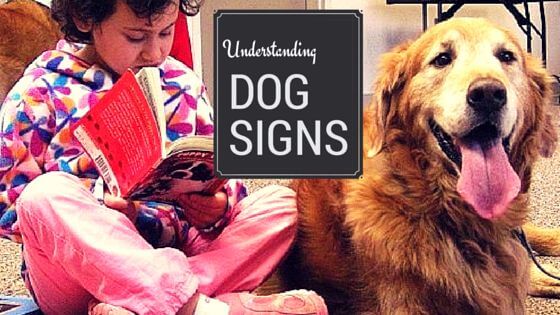
The body language of dogs is relatively easy as compared to humans – they growl when they are angry, they wag their tails when they are friendly, how many humans can we say that for?
Dogs so very often give us cues to their emotional state as well as to their reaction to the worldly elements around them, if only we are listening. Their facial expressions and body postures tell so much more than their barks.
Body language of dogs
Since dogs don’t speak the human tongue, they communicate most of their feelings to us through their instinctual body language. Dogs communicate with one another and with us using non-verbal language. Understanding your dog’s body language goes beyond just a wagging tail. While a happy pup might greet you with a flurry of tail wags, the position and intensity of the wag can tell you more. A relaxed wag held high shows confidence, while a low wag tucked between the legs might indicate fear. Leaning is another important signal.
Leaning against you is usually a sign of affection, but if your dog is also trembling or panting, it could be anxiety. By paying attention to these subtle cues, you can decipher your dog’s emotions and respond accordingly, creating a stronger bond with your furry friend.
These easy-to-read drawings by Lili Chin will help you understand your pooch much better!
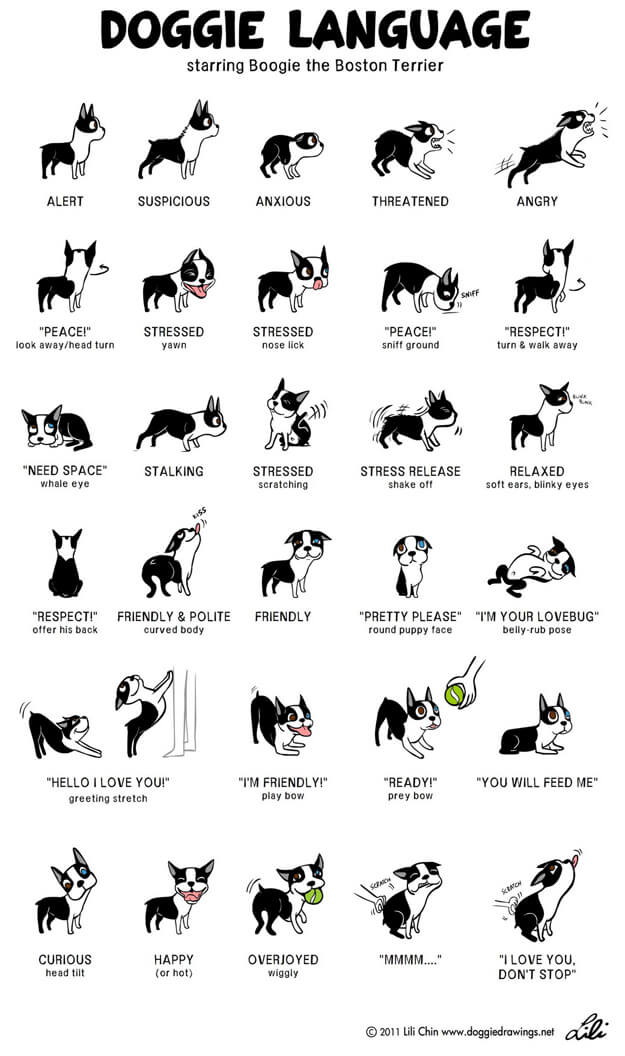
Dogs may not say the words, but they say a lot more once we realize their body language.
Unless you’re a cat living under a rock, you’d know how tricky it can get to listen to what your dog is saying. The Secret Life of Woofs isn’t that hard to comprehend even in today’s world of the internet and instant messages.
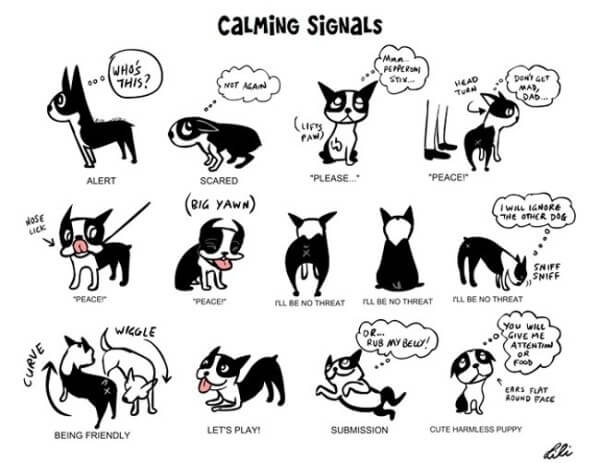
Learning the basics of canine body language helps us in better understanding our canine companions. Once a Dog Listener, we can ease our well-intentioned cross-species miscommunications.
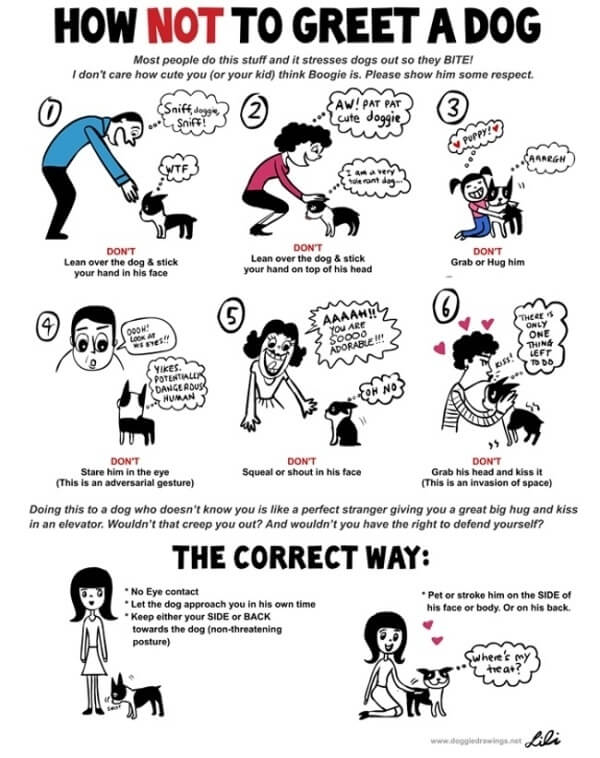
How to tell if a dog is afraid?
An afraid dog would tuck his tail between his rear legs.
A fearful dog often displays bodily postures like leaning away or back, trembling, lowering his body or head – eyes wide open and a wrinkled forehead. Watch out for his tail, which may be lowered or tucked. If he’s too timid, he may try to escape or urinate when approached.
Is the dog displaying aggressive behaviour?
A dog exhibiting an aggressive tone may display a wrinkled muzzle, tense body, with weight either centered or over all four feet or leaning slightly forward onto the front legs. When a dog is feeling tense, his eyes may appear rounder than normal, or they may show a lot of white around the outside.
Also See: Why your dog barks at other dogs?
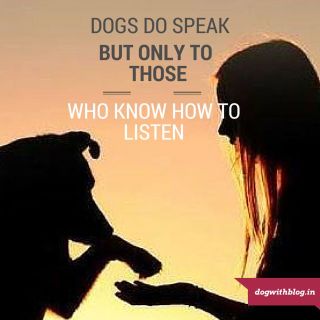
How Dogs Sense Our Emotions – And Why They Deserve Our Full Attention
Ever noticed how your dog just knows when you’re feeling off? Whether you’re stressed after a long day, annoyed there’s nothing good in the fridge, or just plain sad, your dog is often the first to pick up on it. A soft nuzzle, a gentle paw on your knee, or a quiet presence by your side—they’re experts in emotional support.
Dogs Understand Us More Than We Realize
Dogs are incredibly perceptive. Their ability to read our emotions goes beyond wagging tails and eager eyes. Research has shown that dogs are not only attuned to our moods, but also react when they feel neglected. A recent UK study found that dogs exhibit signs of sadness when their humans spend too much time glued to their phones. Yes, really—excessive screen time could be causing emotional distress in your dog.
Dogs read our body language and expressions. So, if you’re buried in your phone and your dog is trying to connect, you’re essentially ignoring them—and they feel that. Time with your dog doesn’t just brighten their day—it’s great for your well-being, too. Numerous studies have proven that interactions with dogs significantly reduce cortisol (the stress hormone), lower blood pressure, and alleviate anxiety and depression.
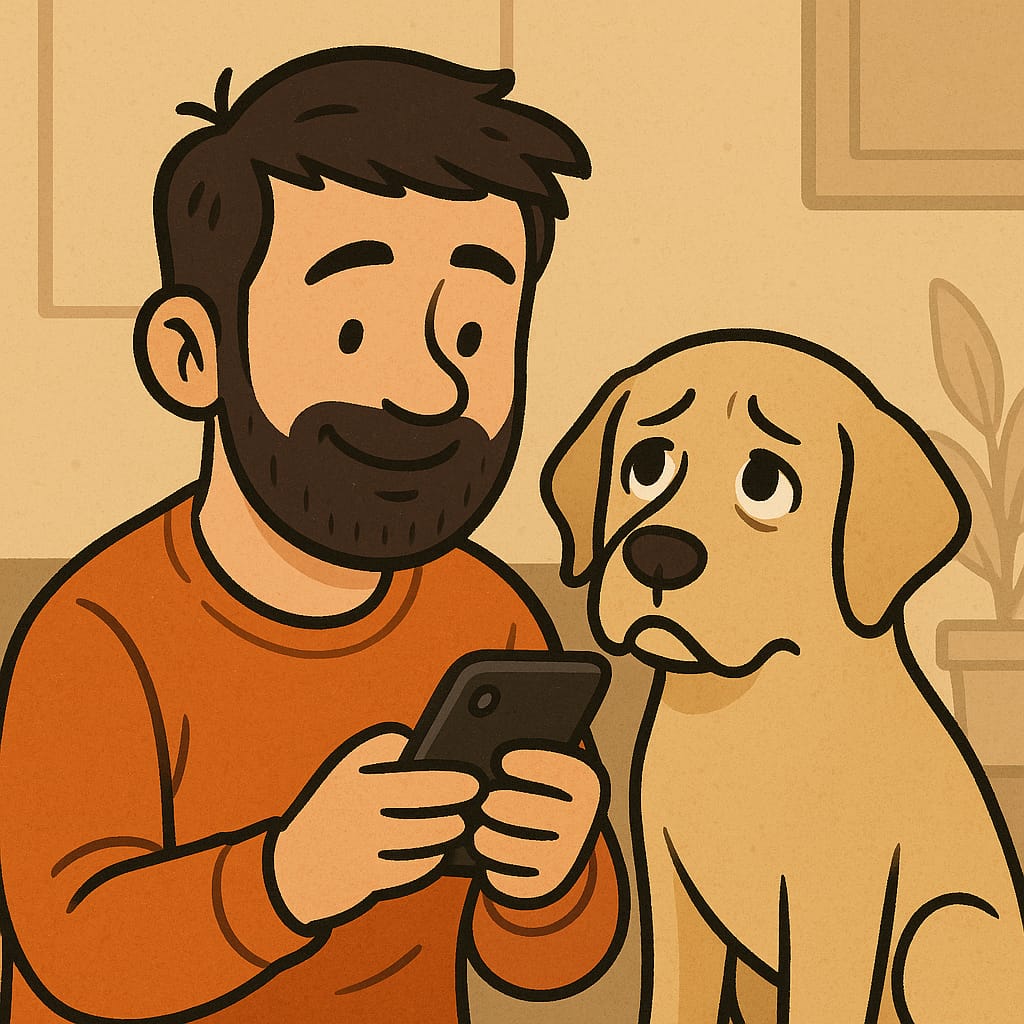
15 Ways to Bond with Your Dog (Instead of Scrolling Your Phone)
If you’re looking for a sign to unplug and reconnect with your furry friend—this is it. Here are some easy, enriching ways to make your dog feel seen, loved, and engaged:
Outdoor Adventures
- Rake up a leaf pile and let them jump in joy
- Go for a walk and let your dog choose the route
- Plan a doggy playdate with their best four-legged pal
- Take a hike through a scenic trail or forest
- Bring a bag of tennis balls and head to an off-leash park
- Visit a dog-friendly beach for some sand-digging fun
Interactive Fun at Home
- Build a DIY ball pit with their favorite toys
- Try blowing bacon-scented bubbles and watch the excitement
- Give your pup a relaxing massage
- Teach them a new trick—clicker training works wonders
- Bake homemade dog treats together
- Read a book aloud while they curl up next to you
- Snuggle under the blankets for a cozy movie night
Every tail wag, happy bark, and soulful stare is your dog saying, “I’m here for you.” It’s only fair we return the favor—with our time, attention, and love.
Why do dogs chase their tails?
Dogs chase their tails for a variety of reasons: curiosity, exercise, anxiety, and predatory instinct or, they might even have fleas. For the behavioural aspects, try including more exercises in your dog’s daily routine – this would also help him reduce anxiety and stress.
We all know a happy pup’s tail wags with unrestrained enthusiasm, but did you know a wag can be like a secret code? That full-body wag held high? Pure confidence. A nervous wiggle tucked low between the legs? Fear might be creeping in. Just like us, dogs wear their emotions on their sleeves – well, tails, in this case. By learning to “read” these wags, you can become a doggy deciphering pro.
Why do dogs lean on you?
Dogs lean on us for a variety of reasons, most commonly to show affection or simply because they enjoy being close to their favorite people. This leaning behavior is a form of communication in dogs, similar to how humans might hug or hold hands. It can also be a sign of anxiety in some cases, so if your dog is leaning on you excessively and showing other signs of nervousness, it’s a good idea to consult a veterinarian or animal behaviorist.
Hope these handy tips will help you know exactly when your pup is bursting with excitement for a walk, or when a cuddle session is the perfect remedy for a less-than-stellar day at the dog park. All set to be Dr Dolittle, are you?
Also see, how to introduce your dog to the baby.
What Your Dog’s Greeting Really Says About Your Relationship—and the Best Way to Respond
Your dog’s behavior every time you walk through the door offers meaningful clues about your connection—along with cues about their overall happiness. From joyful jumps to quiet tail wags, learning what these signals mean can help you build a more trusting, confident relationship with your dog, whether you’re together or apart.
1. Over-the-Top Hellos: Jumping, Barking or Spinning
If your dog greets you by bouncing around, barking for joy, or spinning in circle – they’re showing an intense attachment and pent-up excitement. These exuberant welcomes are often stronger if you’ve been gone longer or if you use an overly enthusiastic tone when arriving home.
How to respond: Enter calmly and quietly. Don’t give attention or affection until your pup settles down. This teaches them that calm greetings are encouraged, helping to balance their emotions and reduce future frenzy.
2. Subdued or Shy Greetings: Lowered Eyes, Soft Tail Wag, Bowed Head
Not all dogs greet with fireworks. Some express affection by lowering their gaze, giving gentle wags, or keeping their head down. This reserved body language can reflect both happiness and respect—especially if they see you as a leader.
How to respond: Get down on their level and speak softly. Avoid looming or making quick movements, which can increase their nervousness. Gentle signals foster trust and help more sensitive dogs feel secure.
3. Presenting Gifts: Toys, Slippers, or Odd Objects
When your dog rushes over with a toy, slipper, or another random object, they’re inviting you to interact. Gift-giving is your dog’s way of saying, “Welcome home—let’s do something fun!” This behavior also hints that they’ve missed your company and may have felt bored on their own.
How to respond: Accept the gift and spend a few moments playing or showing appreciation. Recognizing their effort strengthens your bond and positively reinforces their desire to connect.
4. The Relaxed Greeter: Ignoring Your Arrival
If your dog barely acknowledges your return—no wild tail wagging, no barking, no rush to the door—it’s likely a sign of confidence and security. A relaxed reaction often means your dog feels safe and at ease being alone, with no fear of abandonment.
How to respond: Give them space and let them decide when to approach. Trusting their independence is important—some dogs prefer to reconnect in their own time, just like people do.
5. Vocal Welcomes: Whines, Barks, or Howling
Dogs use their voice to communicate a wide range of feelings. Excited barks and happy whines usually reveal joy, while drawn-out howls or persistent whining may point to stress or unmet needs. Body language—like a wagging tail or pinned-back ears—can help clarify their message.
How to respond: Observe both the sound and body cues. Celebrate joyful noises, but if your dog seems anxious, offer reassurance and check for possible stressors.
Dog Greeting Behaviors: What They Signal & The Best Owner Response
| Behavior | What It Means | Best Response |
|---|---|---|
| Jumping, barking, spinning | High excitement, strong attachment | Calm entrance, reward calm behavior |
| Lowered head, soft tail wag | Submissive affection, reassurance | Gentle voice, crouch to their level |
| Bringing a toy or object | Play invitation, engagement | Accept or play, show appreciation |
| Indifference/ignoring | Secure, well-adjusted, no anxiety | Let them decide when to interact |
| Whining, barking, howling | Expressing emotion, possible stress | Observe cues, comfort if necessary |
By understanding and respecting your dog’s unique behaviors, you not only strengthen your relationship but also support their emotional health—even when life keeps you apart.

Nice post Abhishek.. I have a saint Bernard (His name is Titan) at my home, his huge size makes me scared.. His behavior is kinda neutral towards me, he neither barks at me nor ever come near to me.. What does it means?? He likes me or not?
Hi Anjali, Dogs can smell apprehension, please let go of fear 🙂 Bernard(s) despite their size are very friendly hence the title Saint. Try to take it slow, bond with him by being the one who gives him food, takes him out for walks and I’m sure you’ll make great friends with him. All the best!
A lot of things I have learned from this blog.